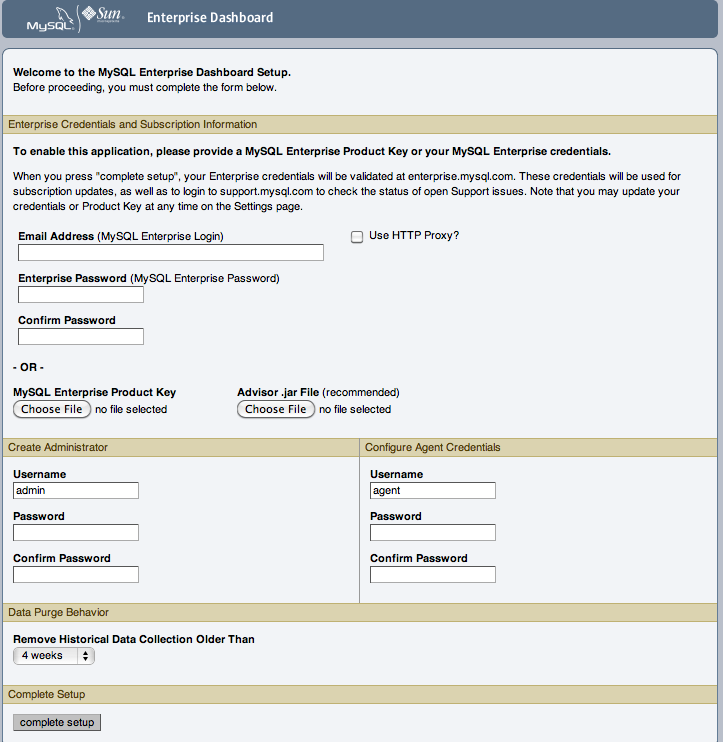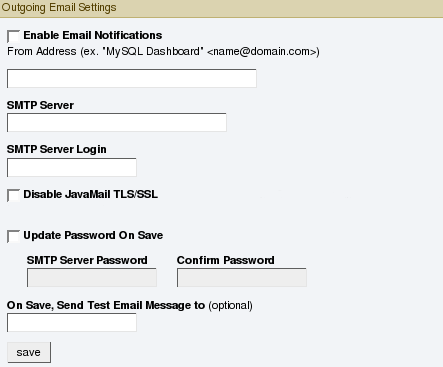- 15.3.2 Service Manager Installation
- 15.3.2.1 Service Manager Installation Common Parameters
- 15.3.2.2 Service Manager Installation on Windows
- 15.3.2.3 Service Manager Installation on Mac OS X
- 15.3.2.4 Service Manager Installation on Unix
- 15.3.2.5 Starting/Stopping the MySQL Enterprise Monitor Service on Windows
- 15.3.2.6 Starting/Stopping the MySQL Enterprise Monitor Service on Unix and Mac OS X
- 15.3.2.7 MySQL Enterprise Service Manager Configuration Settings and Advisor Installation
[+/-]
The Enterprise Dashboard is the web-based interface to the Service Manager so the procedure for starting the dashboard is identical for all platforms. From the dashboard you can configure the settings necessary for receiving updates from MySQL Enterprise and for the initial installation of the Advisors.
If you installed the Service Manager using a graphical interface, you have the option of launching the dashboard on the final installation screen (as long as the Launch MySQL Enterprise Monitor Now checkbox is checked).
Otherwise, you can view the dashboard by typing
http://localhost:
into the address bar of your web browser. If you are unsure of the
host name and port to use, check the
18080/Auth.actionconfiguration_report.txt file.
Under Windows it is also possible to open the dashboard by
choosing the MySQL menu item and finding the
MySQL Enterprise Monitor entry. Under this entry choose
Start Service Manager.
If this is the first time that you have attempted to log in to the dashboard you should see a screen similar to the following:
Use this screen to perform the following tasks:
Install the Advisors
Set up your MySQL Enterprise credentials
Create a user name and password for the dashboard administrator
Create a user name and password for the Monitor Agent
If you have been provided with a MySQL Enterprise
Product Key and an Advisors file click the
Browse button and locate these files. The
advisor file bears the name,
AdvisorScript-
and the product key,
version.jarSubscription-level_date.xml
Note
If you are activating the MySQL Enterprise Monitor using a product key donot enter your MySQL credentials; entering both produces an error message.
If you have Internet access from the dashboard, activate
MySQL Enterprise Monitor by supplying your MySQL Enterprise credentials. Enter
your email address as the MySQL Enterprise
Login and enter and confirm your MySQL Enterprise
password. If you specify incorrect credentials, you receive the
error message, “Unable to connect to verify
credentials.”
In the Create Administrator section of this
screen, enter credentials for the dashboard administrator. This
creates the root user described in
Section 15.3.1.3, “Users Created on First Log-in”. Make note of
the user name and password as these credentials are required for
any future login.
In the Configure Agent Credentials section
of this screen enter the credentials for the agent. This is the
agent user also described in
Section 15.3.1.3, “Users Created on First Log-in”. The agent needs
to log in in order to report its findings. Make note of the
agent's credentials; this information is required when
installing the agent.
When all the settings have been specified, click the complete setup button. If you log in successfully you should see a message displaying the number of graphs and advisors that have been imported. This number varies depending upon your subscription level.
If importation of the advisor files fails, you will see the message:
Unable to import Advisor Jar. You may download the jar manually from the Enterprise Portal and import it from the 'Check For Updates' page.
In this case you may download the advisor file from the Enterprise website and install it as described in Section 15.3.2.7.3, “Installing Advisors After Initial Log-in”.
If this is the first time that you have launched the dashboard you are asked to set your time zone and locale. Choose the appropriate values from the drop-down list boxes. Setting the time zone ensures that you have an accurate time reference for any notifications from the MySQL Enterprise Advisors.
Warning
It is especially important that the time zone be set correctly as this may also affect the way the graphs display. For this reason, also ensure that the time reported by the operating system is correct. To change the time zone or locale see Section 15.5.2, “User Preferences”.
The locale chosen determines the user's default language when logging in to the Dashboard. Note that this will override the default browser settings whenever this specific user logs in.
After specifying your time zone and locale, the dashboard opens
on the Monitor page. For a detailed
examination of the Monitor Screen see,
Section 15.4, “MySQL Enterprise Dashboard”.
The Advisors interpret the data sent by the Monitor Agents and display the results in the dashboard. A minimal set of Advisors are preinstalled with the Service Manager. To obtain the full set of Advisors and get the most value from the MySQL Enterprise Monitor, you must download Advisors from MySQL Enterprise.
If you did not install the Advisors when you first logged in to
the MySQL Enterprise Dashboard, open the dashboard, find the
Advisors tab, and choose the Check
for Updates link. Doing this downloads the latest
version of the Advisors from the MySQL Enterprise web site. In
order to install the advisors in this fashion you must specify
your MySQL Enterprise credentials. Find instructions for doing
this in Section 15.5.1, “Global Settings”.
If you do not allow Internet access from the dashboard, you must
install the Advisors from a local file. To do this you need an
advisor file bearing the name,
AdvisorScript-.
If you don't already have this file, you can find it on the
MySQL Enterprise downloads page. Download the Advisors file to
a location that is accessible from the dashboard. Use the
Browse button to find the Advisors file
and then choose import to load the
advisors.
version.jar
The process for upgrading advisors is exactly the same as the
initial installation. Advisors are updated by choosing the
update button on the Check for
Updates page. If you do not have Internet access from
the dashboard you can import the Advisors from a local file as
described in
Section 15.3.2.7.3, “Installing Advisors After Initial Log-in”.
Note
You may choose to upgrade your MySQL Enterprise Monitor subscription level at any time.
Alert notification via email is a key component of the MySQL Enterprise Monitor Advisor solution. For this reason you may want to immediately configure an SMTP account for at least one recipient.
To do this choose the Settings tab and go to
the Global Settings screen by clicking the
appropriate link. Here you can configure the email settings.
These settings apply to the currently logged-in user.
Find the Outgoing Email Settings on the left
of this page.
Ensure that the Enable Email Notifications
checkbox is checked and enter information as appropriate.
The default value for the SMTP port is 25. If
your mail server runs on a different port simply specify it,
separating it from the server name using a colon. For example,
if your mail server runs on port 587 enter
email.myserver.com:587
Note
An email server must be available for sending email alerts.
The SMTP client uses Transport Layer Security (TLS) if the SMTP server supports it.
If your SMTP server incorrectly indicates that it supports TLS, check the Disable JavaMail TLS/SSL check box.
The email settings page is dealt with in more detail in Section 15.5, “The Settings Page”.



User Comments
Add your own comment.